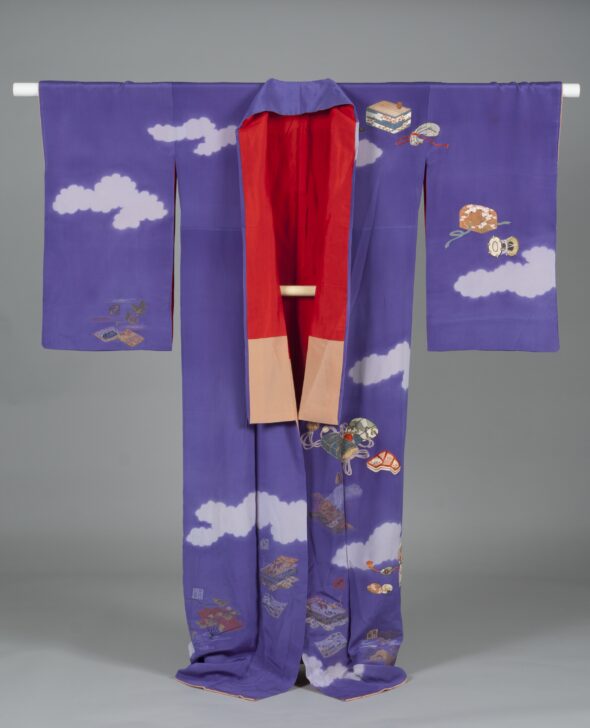Kimono
Japanese

Description
The design on this colorful kimono alludes to the game of genjikō, an incense-matching game popular among aristocrats during the Heian period (794–1185). Incense was likely brought to Japan along with Buddhism, some time in the sixth century. “The way of fragrance,” or kōdō, consisted of both appreciation for and distinction between
different scents. Aristocrats enjoyed friendly competitions in which they challenged one another to distinguish scents, which was seen as a playful way to showcase one’s sophistication. Incense is often featured in The Tale of Genji, and the purple color of the kimono alludes to the novel’s author, Murasaki Shikibu (ca. 973–1025), whose surname,
Murasaki, also means purple.
Subject Matter:
Yuzen is a stretch-resist dyeing technique invented by Miyazaki Yuzen, a famous Kyoto fan-painter during the Gentoku era (1688-1704). Yuzen has two dyeing styles: “Tegaki Yuzen” hand painting and “Kata Yuzen” stencil dyeing.
“Tegaki Yuzen” is the more traditional technique. Its hand-painting skills create beautiful and elaborate designs. “Tegaki Yuzen” is named differently according to the place in which it was produced: Kyo Yuzen (Kyoto), Kaga Yuzen (Ishikawa) and Tokyo Yuzen (Tokyo). They are the three major Yuzen in Japan. Among these, Kyo Yuzen is considered the most gorgeous and elegant.
Chirimen refers to the unique wrinkled texture, also called crepe texture, created by a specific weaving technique. This texture is often used with traditional Japanese fabrics, often silk, wool, or synthetic fiber.
Houmongi is a semi-formal kimono that can be worn by both married and single women for social events. It is called second-class formal wear.
Houmongi is created by a patterning method called “Eba:” the pattern is dyed in such a way that it creates an unbroken design across the seams when the kimono is sewn together.
The inner lining includes eight different parts (hakkake) on the bottom and sleeve edges that gives the inner lining a more colorful appearance.
Physical Description:
Purple chirimen Houmongi with dyed clouds and interwoven and tegaki yuzen (handpainted stencil) dyed oogi (fan), hand drums, bags, shells, treasure boxes, pine, instruments, books, arrows, and various flowers with three kamon (family crests), located on the back and back sleeves, with a red and orange silk lining. On 10 Genjiko motifs (geometrical motif symbolizes combinations of incense fragrances. The incensing-matching game was popular among the Heian 794-1185 nobility.), each one of them has the chapter title of The Tale of Genji ( Genji monogatari, pronounced is a classic work of Japanese literature written by the noblewoman and lady-in-waiting Murasaki Shikibu in the early years of the 11th century)
Usage Rights:
If you are interested in using an image for a publication, please visit https://umma.umich.edu/request-image/ for more information and to fill out the online Image Rights and Reproductions Request Form.